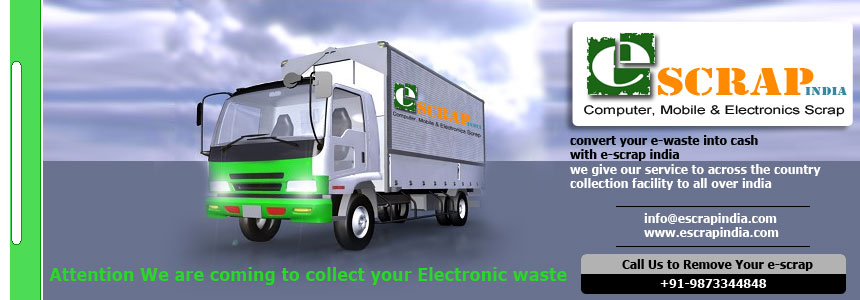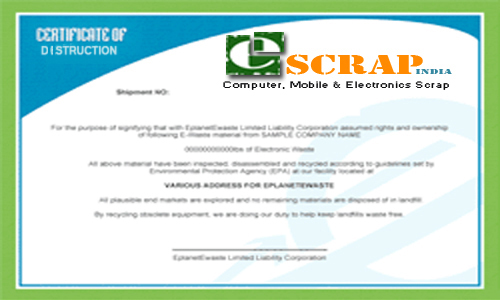RECYCLING
Recycling of e-waste is not required merely because it is mandatory or environmental requirement, but is also essential to avoid bad publicity when computers and other office automation systems are found in landfill or third world countries, consequently, the industry is on the brink of a paradigm shift with respect to cost avoidance v/s risk avoidance.
In India there is excellent technology and machineries for recycling of electrical & electronic waste to suit the environmental objective and best recovery practices. The process is a combination of manual and mechanical dismantling, size reduction, segregation, dust collection as well as sending hazardous waste for final disposal and precious metal bearing components for refining. Entire system is based on the principles of clean environment and zero landfill.
E scrap India has its own fleet of trucks and also has tied up with national level logistic companies to transport e-waste to its facility.

PROCESS of RECYCLING
Recycling activities commences with the receipt of e-waste material from various clients' locations. The material is initially weighed, and is separated product-wise (monitors, CPUs, printers, keyboards, etc.) for easy retrieval. The material is then checked by qualified technicians to ascertain whether the equipments are working or non-working. If the equipment is in working/ near-working condition, then the technicians attempt to repair/ upgrade the equipments to ensure that they become re-marketable and can be resold. If the equipments are not in working condition, attempts are being made to salvage components. Accordingly, the technicians dismantle the equipment into components and try to retrieve any working parts thereof.
The residual components are then passed on for shredding into the twin-shaft shredder. helps to “open up” sealed components, separating metals from plastic. The shredder accepts manually dismantled components through a hopper at one end, passes the feed through the shredding chamber where two counter rotating hexagonal shafts fitted with circular blades shred the components, and the shredded items are dropped onto a moving conveyor belt.
Certain components of the computer such as printed circuit boards (PCBs) contain precious metals such as gold, silver, etc. These PCBs are not sent for shredding and are instead accumulated and would be used for precious metal extraction. That portion of e-waste which contains hazardous elements and cannot be recycled is sent to authorised hazardous waste treatment and disposal facilities for final disposal as per the norms of the Pollution Board.

Hazardous substances recovered during the process of recycling of e-waste are being disposed off through the Common Hazardous Waste Treatment, Storage & Disposal Facility, commonly known as CHWTSDF, authorized by the Pollution Control Board in the prescribed manner.
Extraction of Precious Metals Developing a Cost-Effective and Feasible Method for Precious Metal ExtractionExtraction of precious metals out of e-waste material is an integral and a very important part of the entire e-waste recycling chain. There are only a few companies in the world such as Umicore at Belgium, Boliden at Sweden, Xstrata in Canada, DOWA in Japan, etc. which possess the necessary technical know-how to address this requirement of e-waste recyclers globally. These companies, which have been set up with huge amounts of investment, are pre-dominantly mining companies which also perform the add-on activity of precious metal extraction for e-waste recyclers. Given their overseas locations, e-waste material is usually accumulated domestically until the volumes justify the expense involved in transporting them to these factories for extraction of precious metals.
Given the rising levels of penetration of computers and communication equipments especially in the SAARC countries, and the extent of e-waste that gets generated due to their obsolescence, there is a great scope of developing a precious metal extraction unit in India, which could cater to the local demand, as well as demand from the neighboring countries.
E scrap India is currently working on developing a cost effective and feasible method for extraction of precious metals from e-waste.
E scrap India acknowledges distructon of material by issuing Certificate of Distruction in the following format





